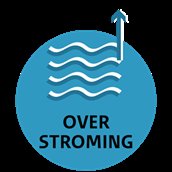How can we mitigate the risks and consequences?
Dutch flood risk management policy is referred to as “multi-layer flood risk management”, as the approach comprises several “layers”:
- Layer 1: Flood prevention. The national government sets down standards for the primary flood defences, and the provinces do so for the regional flood defences. Rijkswaterstaat [the executive branch of the Ministry of Infrastructure and Water Management] and the district water boards are responsible for the construction, management, and maintenance of dykes and other flood defences. Under the Room for the Rivers programme, they are creating more room for the safe discharge of water.
- Layer 2: Mitigating the impact of flooding through spatial planning measures. Examples are elevated construction at a location that is relatively highly prone to flooding, and preferably not constructing vital functions in flood-prone areas. Involved in this layer are the national government, the provinces, municipalities, and district water boards, in addition to the managing authorities of vital and vulnerable functions, and in many cases, private-sector parties.
- Layer 3: Mitigating the impact of flooding by preparing, to the maximum extent possible, for a potential disaster. For example, by drawing up evacuation plans and creating shelter locations. Coordination is vested with the national government; the provinces supervise the district water boards; and the district water boards are responsible for implementing contingency plans, pumping, and monitoring and restoring dykes in the event of calamities. The municipalities are responsible for communication with residents and the coordination of evacuations.
In its final report (in Dutch), the Waterlogging and Flooding Policy Platform recommends adding two additional layers to the multi-layer flood risk management strategy: “water awareness” and “restoration”. One of the main conclusions of this Policy Platform is that water awareness is imperative for all Dutch residents, as is enhancing their coping capacity. Are you interested in raising water awareness among your residents and in encouraging them to prepare well for potential flooding? The Toolkit for Basic Communication in the Event of Waterlogging, Flooding, Heat, and Drought (in Dutch) may be helpful.
The video below explains how to mitigate the impact of flooding by implementing layer 2 and layer 3 measures.
